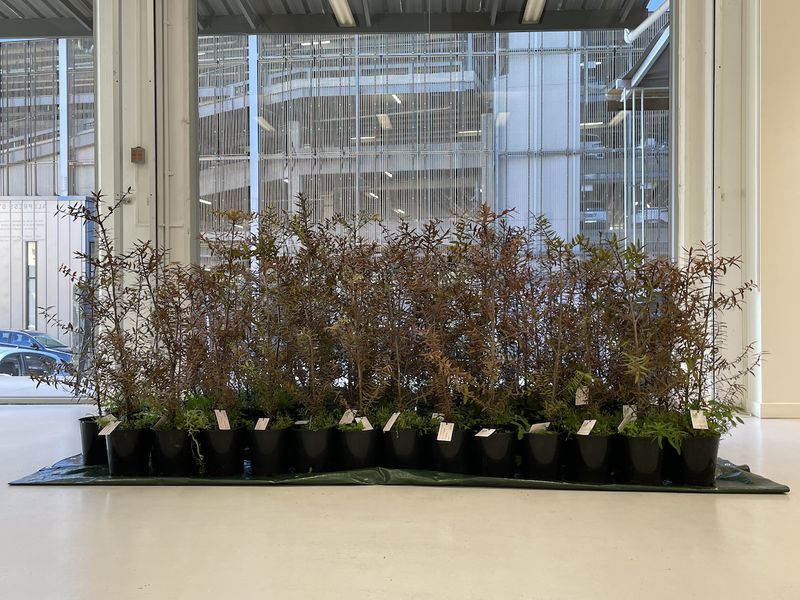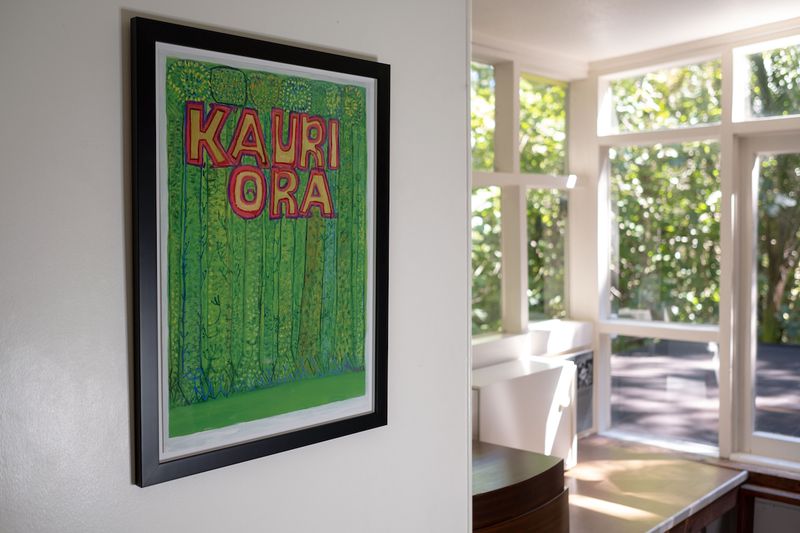Kauri Ora exhibition and Artist Talk
Allpress Studio
7 May 2022
Featuring an exhibition of kauri works by Colin McCahon, Emily Karaka, Shane Cotton, Imogen Taylor, and Cora-Allan Wickliffe, natural pigment-making activity for tamariki and whānau, and an artist talk with Emily Karaka, Cora-Allan Lafaiki Twiss, and Nigel Borell on Thursday, 5 May at 6 pm.
Throughout the week, Kauri Ora open editions by Emily Karaka are available to purchase, as well as limited editions of McCahon House Kauri Project saplings. Grown from the very trees that were loved and painted by Colin McCahon from his Titirangi home of the 1950s, this new generation of kauri are confirmed to be free of kauri dieback disease.
To purchase the Kauri Ora editions by Emily Karaka, and McCahon House Kauri Project saplings, visit our online store.

McCahon House Kauri Project saplings at Kauri Ora - A Celebration of New Zealanders' Love for Kauri, at Allpress Gallery, 5 - 8 May 2022.

Emily Karaka, Kauri Ora (green) at McCahon House Museum 2022. Photo: McCahon House.
Featuring an exhibition of kauri works by Colin McCahon, Emily Karaka, Shane Cotton, Imogen Taylor, and Cora-Allan Wickliffe, natural pigment-making activity for tamariki and whānau, and an artist talk with Emily Karaka, Cora-Allan Lafaiki Twiss, and Nigel Borell on Thursday, 5 May at 6 pm.
Throughout the week, Kauri Ora open editions by Emily Karaka are available to purchase, as well as limited editions of McCahon House Kauri Project saplings. Grown from the very trees that were loved and painted by Colin McCahon from his Titirangi home of the 1950s, this new generation of kauri are confirmed to be free of kauri dieback disease.
To purchase the Kauri Ora editions by Emily Karaka, and McCahon House Kauri Project saplings, visit our online store.
Planting and aftercare of your kauri
Site conditions: Does best in a well-lit position in moist but well-drained soil.
Planting
- Careful consideration should be given to the selection and positioning of your kauri. Avoid planting near underground services and concrete. Best planted in large gardens for long-lived kauri so that it can reach a mature size.
- Kauri may be planted at any time throughout the year provided they are watered during dry periods. However, the best time of year to plant is after autumn rains when the soil is moist and warm which allows trees to become established before winter. This enables them to withstand dry periods during the following summer.
- Planting success is often improved on clay soils by adding extra topsoil. Incorporate coarse sand, bark, peat, compost, or other organic material to improve soil structure.
- Before planting ensure that the root-ball is saturated and remove the planter bag with minimal root disturbance. Trim any broken roots or branches and plant at the same level as in the container.
- Dig a hole twice the size of the root ball, place plant in the hole and then gently pack soil around it until it is covered.
Aftercare
- The root-ball sometimes dries out despite the surrounding soil being moist; direct water down the plant stem to saturate the root-ball. The first summer and autumn after planting are critical for young plants; water thoroughly during dry periods. Tree should not require watering when established.
- Mulching helps conserve moisture and suppress weeds; organic materials such as sawdust and bark contribute to soil structure as they decompose. Keep mulching material away from plant stems.